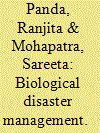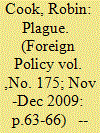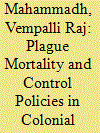| Srl | Item |
| 1 |
ID:
102725


|
|
|
| 2 |
ID:
170056


|
|
|
|
|
| Summary/Abstract |
The cholera and plague pandemics of the 19th and early 20h centuries shaped Ottoman state-building and expansionist efforts in Iraq and the Gulf in significant ways. For Ottoman officials, these pandemics brought attention to the possible role of Qajar and British subjects in spreading cholera and plague, as well as the relationship between Iraq's ecology and recurring outbreaks. These developments paved the way for the expansion of Ottoman health institutions, such as quarantines, and the emergence of new conceptions of public health in the region. Specifically, quarantines proved instrumental not only to the delineation of the Ottoman–Qajar border, but also to defining an emerging Ottoman role in shaping Gulf affairs. Moreover, the Ottomans’ use of quarantines and simultaneous efforts to develop sanitary policies informed by local ecological realities signal a localized and ad hoc approach to disease prevention that has been overlooked. Ultimately, this study demonstrates that environmental factors operating on global and regional scales were just as important as geopolitical factors in shaping Ottoman rule in Iraq and the Gulf during the late Ottoman period.
|
|
|
|
|
|
|
|
|
|
|
|
|
|
|
|
| 3 |
ID:
091467


|
|
|
|
|
| Publication |
2009.
|
| Summary/Abstract |
Sometimes fiction can do more to change public opinion than nonfiction. It took Uption Sinclair's 1906 novel, The jungle, to awaken the public to the dangers of sausage and the meat-packing industry in general.
|
|
|
|
|
|
|
|
|
|
|
|
|
|
|
|
| 4 |
ID:
174908


|
|
|
|
|
| Summary/Abstract |
Focused on colonial South India, this article presents and assesses detailed archival records of public health measures in response to plague outbreaks between 1900 and 1947. Starting in 1897 in the Madras Presidency, the colonial government strictly implemented anti-plague measures and introduced various health schemes and medical policies for plague prevention. However, despite partly vigorous government efforts, plague outbreaks could not be fully controlled. In the twentieth and twenty-first centuries, the plague remains among South Asia’s most feared epidemics, with an outbreak in Surat in 1994 causing major havoc. Neither indigenous knowledge nor Western medical systems provided fully effective remedies regarding causation, cure and prevention of plague epidemics. Since the article gained new relevance in light of current struggles faced by India’s public health system in handling the ongoing COVID-19 pandemic, some lessons from history emerge in the concluding discussion.
|
|
|
|
|
|
|
|
|
|
|
|
|
|
|
|
| 5 |
ID:
179848


|
|
|
|
|
| Summary/Abstract |
This article considers the celebrated elegy by the classical 7th-century Arabic poet, Abu Dhuʾayb al-Hudhali — his ʿayniyya, which ends with ʿayn as a rhyming letter. Analyzing the poem's structure and comparing it with that of two poems composed by Abu Dhuʾayb's teacher, Saʿida b. Juʾayya al-Hudhali, leads to the conclusion that Saʿida's two poems were the main sources on which the pupil drew to create his poem. The sophisticated changes that Abu Dhuʾayb introduced in structure and content, however, made his poem more memorable than those of his teacher. The article raises another question, to which there is, as yet, no definitive answer: what was the true inspiration for Abu Dhuʾayb's poem? Was it the death of his sons, as is traditionally believed, or was it literary: to surpass his teacher in composing a more skillful poem?
|
|
|
|
|
|
|
|
|
|
|
|
|
|
|
|